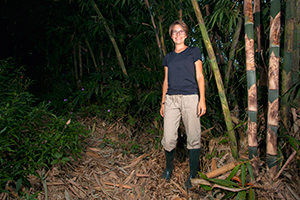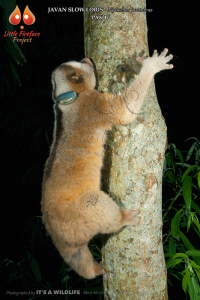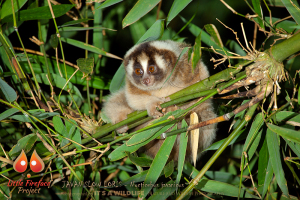 Swinging out on a loose branch, feet dangling in the air and scrambling to catch something to rest on over a messy expanse of bamboo and brush is not exactly what I ever imagined I’d be doing at four in the morning. But I’ve quickly learned out here that the term “slow loris” is a complete misnomer when you begin to follow these busy animals and that falling isn’t so much a question of whether or not it will happen but when. With all of the layers I’ve been putting on to combat the cold nights, I sometimes feel like a toddler in a snowsuit, tumbling clumsily onto pile after pile of leaves instead of banks of snow.
Swinging out on a loose branch, feet dangling in the air and scrambling to catch something to rest on over a messy expanse of bamboo and brush is not exactly what I ever imagined I’d be doing at four in the morning. But I’ve quickly learned out here that the term “slow loris” is a complete misnomer when you begin to follow these busy animals and that falling isn’t so much a question of whether or not it will happen but when. With all of the layers I’ve been putting on to combat the cold nights, I sometimes feel like a toddler in a snowsuit, tumbling clumsily onto pile after pile of leaves instead of banks of snow.
Of course, I haven’t constantly been chasing after the loris. Nights bring wonderful moments of calm as the loris comb through the trees. It’s amazing to see their concentrated gaze, the glowing red of their eyes in the beam of a head torch, as they move step by calculated step across a branch. In an instant, though, you can literally blink, and they’re gone. They can move up and across trees like any of us stroll down the sidewalk and can cross into a different part of the forest in an amount of time that doesn’t seem, maybe isn’t even, humanly possible. Hence the scrambling over hills and the swinging out over piles of bamboo in an attempt to keep up.
 Let me preface the rest of this by saying that it is impossible to write about what nights out with the loris look and feel like without including an embarrassing amount of mush. The night is just beautiful. I’ve seen fog roll in so thick we just had to hunker down and wait, our red lights feebly cutting through the fog like a band of Rudolfs on Christmas Eve. Calls from the mosque mix with the business of a limitless array of bugs, birds and frogs. Light plays on the tops of leaves like fireflies. Coming from the city, I remember wishing on the handful of stars as a child I’d be lucky to make out in the haze. Out here there are thousands to choose from, all accompanied by the clearest moonlight I’ve ever seen. The scale of it all makes you feel so small, in the best possible way.
Let me preface the rest of this by saying that it is impossible to write about what nights out with the loris look and feel like without including an embarrassing amount of mush. The night is just beautiful. I’ve seen fog roll in so thick we just had to hunker down and wait, our red lights feebly cutting through the fog like a band of Rudolfs on Christmas Eve. Calls from the mosque mix with the business of a limitless array of bugs, birds and frogs. Light plays on the tops of leaves like fireflies. Coming from the city, I remember wishing on the handful of stars as a child I’d be lucky to make out in the haze. Out here there are thousands to choose from, all accompanied by the clearest moonlight I’ve ever seen. The scale of it all makes you feel so small, in the best possible way.
I think we all have a small bank of places we visit and revisit in our heads, never allowing ourselves to leave them behind. Two weeks in the field, and I’ve already got a new one: the trails and tea farms that we frequent up in Loris Land. I will never get used to the twin twinkling scenes we are treated to here on a nightly basis, the stars overhead and the city of Garut blinking below. I will never, I hope, pass by an owl or loris up in a tree and think, “Oh, what else is new?”
 It has been absolutely incredible experiencing these animals’ lives and their homes firsthand. Unfortunately it is also all too worrisome that day by day places like this, maybe even this place, are disappearing piece by piece. What can we do to make sure that habitats like Loris Land don’t just become a place we revisit in our head someday? In my brief time working with the Little Fireface Project, I think there is an answer here. I’m so lucky to experience research and conservation work firsthand here, to see what outreach and education projects can do. To put it all too simply, in my few weeks in West Java, I think they can do an awful lot.
It has been absolutely incredible experiencing these animals’ lives and their homes firsthand. Unfortunately it is also all too worrisome that day by day places like this, maybe even this place, are disappearing piece by piece. What can we do to make sure that habitats like Loris Land don’t just become a place we revisit in our head someday? In my brief time working with the Little Fireface Project, I think there is an answer here. I’m so lucky to experience research and conservation work firsthand here, to see what outreach and education projects can do. To put it all too simply, in my few weeks in West Java, I think they can do an awful lot.
Katherine Kling – Student Volunteer
